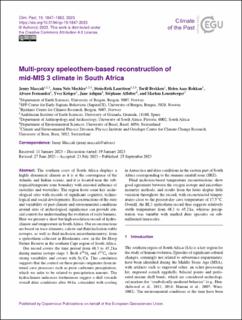| dc.contributor.author | Maccali, Jenny Marianne | |
| dc.contributor.author | Meckler, Anna Nele | |
| dc.contributor.author | Lauritzen, Stein Erik | |
| dc.contributor.author | Brekken, Torill | |
| dc.contributor.author | Rokkan, Helen Aase | |
| dc.contributor.author | Bremer, Alvaro Fernandez | |
| dc.contributor.author | Krüger, Yves Stephan | |
| dc.contributor.author | Adigun, Jane | |
| dc.contributor.author | Affolter, Stéphane | |
| dc.contributor.author | Leuenberger, Markus | |
| dc.date.accessioned | 2023-09-29T11:25:19Z | |
| dc.date.available | 2023-09-29T11:25:19Z | |
| dc.date.created | 2023-01-26T16:16:55Z | |
| dc.date.issued | 2023 | |
| dc.identifier.issn | 1814-9324 | |
| dc.identifier.uri | https://hdl.handle.net/11250/3093091 | |
| dc.description.abstract | The southern coast of South Africa displays a highly dynamical climate as it is at the convergence of the Atlantic and Indian oceans, and it is located near the subtropical/temperate zone boundary with seasonal influence of easterlies and westerlies. The region hosts some key archeological sites with records of significant cognitive, technological and social developments. Reconstructions of the state and variability of past climate and environmental conditions around sites of archeological significance can provide crucial context for understanding the evolution of early humans. Here we present a short but high-resolution record of hydroclimate and temperature in South Africa. Our reconstructions are based on trace elements, calcite and fluid inclusion stable isotopes, as well as fluid inclusion microthermometry, from a speleothem collected in Bloukrantz cave, in the De Hoop Nature Reserve in the southern Cape region of South Africa.
Our record covers the time period from 48.3 to 45.2 ka during marine isotope stage 3. Both δ18Oc and δ13Cc show strong variability and covary with Sr / Ca. This correlation suggests that the control on these proxies originates from internal cave processes such as prior carbonate precipitation, which we infer to be related to precipitation amount. The hydroclimate indicators furthermore suggest a shift towards overall drier conditions after 46 ka, coincident with cooling in Antarctica and drier conditions in the eastern part of South Africa corresponding to the summer rainfall zone (SRZ).
Fluid inclusion-based temperature reconstructions show good agreement between the oxygen isotope and microthermometry methods, and results from the latter display little variation throughout the record, with reconstructed temperatures close to the present-day cave temperature of 17.5 ∘C. Overall, the BL3 speleothem record thus suggests relatively stable temperature from 48.3 to 45.2 ka, whereas precipitation was variable with marked drier episodes on sub-millennial timescales. | en_US |
| dc.language.iso | eng | en_US |
| dc.publisher | Copernicus Publications | en_US |
| dc.rights | Navngivelse 4.0 Internasjonal | * |
| dc.rights.uri | http://creativecommons.org/licenses/by/4.0/deed.no | * |
| dc.title | Multi-proxy speleothem-based reconstruction of mid-MIS 3 climate in South Africa | en_US |
| dc.type | Journal article | en_US |
| dc.type | Peer reviewed | en_US |
| dc.description.version | publishedVersion | en_US |
| dc.rights.holder | Copyright 2023 The Author(s) | en_US |
| cristin.ispublished | true | |
| cristin.fulltext | preprint | |
| cristin.fulltext | original | |
| cristin.qualitycode | 1 | |
| dc.identifier.doi | 10.5194/cp-19-1847-2023 | |
| dc.identifier.cristin | 2115963 | |
| dc.source.journal | Climate of the Past | en_US |
| dc.source.pagenumber | 1847-1862 | en_US |
| dc.relation.project | Norges forskningsråd: 262618 | en_US |
| dc.identifier.citation | Climate of the Past. 2023, 19 (9), 1847-1862. | en_US |
| dc.source.volume | 19 | en_US |
| dc.source.issue | 9 | en_US |

